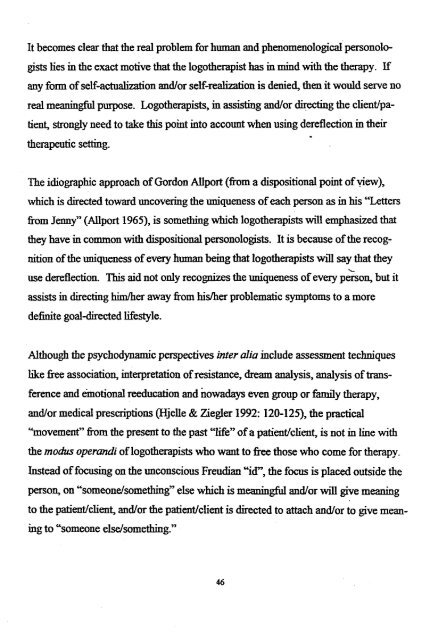View/Open - UZSpace Home
View/Open - UZSpace Home
View/Open - UZSpace Home
Create successful ePaper yourself
Turn your PDF publications into a flip-book with our unique Google optimized e-Paper software.
It becomes clearthat the real problem for humanand phenomenological personolo<br />
gists lies in the exact motive that the logotherapist has in mindwith the therapy. If<br />
anyformofself-actualization andlorself-realization is denied, then it would serve no<br />
real meaningful purpose. Logotherapists, in assistingandlordirecting the client/pa<br />
tient, strongly need to take this point into account when usingdereflection in their<br />
therapeutic setting.<br />
Theidiographic approachofGordonAllport (from a dispositional point ofview),<br />
whichis directedtoward uncovering the uniqueness ofeach person as in his "Letters<br />
from Jenny"(Allport 1965),is something whichlogotherapists will emphasized that<br />
theyhave in common with dispositional personologists. It is because ofthe recog<br />
nition ofthe uniqueness ofevery human being thatlogotherapists will say thatthey<br />
"use<br />
dereflection. Thisaid not onlyrecognizesthe uniqueness ofeveryperson, but it<br />
assistsin directing himlher away from hislher problematic symptoms to a more<br />
definite goal-directed lifestyle.<br />
Although the psychodynamic perspectivesinteralia includeassessment techniques<br />
like free association, interpretation ofresistance, dream analysis, analysisoftrans<br />
ference and emotional reeducation and nowadays even group or family therapy,<br />
andlormedical prescriptions (Hjelle & Ziegler 1992: 120-125), the practical<br />
"movement" from the presentto the past "life" ofa patient/client, is not in line with<br />
the modusoperandi oflogotherapists who want to free those who come for therapy.<br />
Insteadoffocusing on the unconscious Freudian"id", the focus is placed outside the<br />
person,on "someone/something" else which is meaningful andlorwill give meaning<br />
to the patient/client, andlorthe patient/client is directed to attach andlor to give mean<br />
ing to "someoneelse/something."<br />
46
















